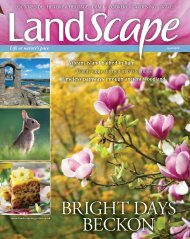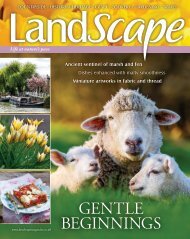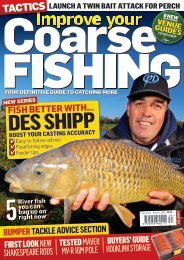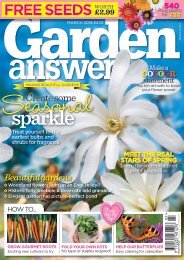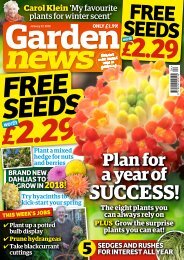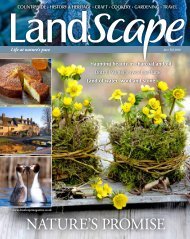Create successful ePaper yourself
Turn your PDF publications into a flip-book with our unique Google optimized e-Paper software.
THE NEXT<br />
GENERATION<br />
blickwinkel / Alamy<br />
MEET THE YOUNG BIRDERS MAKING A DIFFERENCE
THE NEXT GENERATION<br />
Living the dream<br />
Think making a career of watching birds in a uniquely remote location is an<br />
impossible dream? <strong>Young</strong> naturalist Nicola Boulton has done just that…<br />
BY NICOLA BOULTON<br />
Nicola Boulton is a 27-year-old<br />
zoo biologist, and works as a<br />
wildlife guide and<br />
photographer on the western<br />
coast of Scotland.<br />
Follow her on Facebook:<br />
Nicola Boulton Photography<br />
FROM A VERY young age, I was lucky enough to know what I<br />
wanted to do with my life... see the world and all the awesome<br />
wildlife it had to offer. After graduation with a degree in Zoo<br />
Biology four years ago, I decided the best way to do that would<br />
be to pursue a career in wildlife tourism. Guiding is not only a<br />
great way to see wildlife yourself, but it works as a fantastic<br />
platform to educate others. It gives me an opportunity to<br />
permanently extend my education, learn as much as I can about<br />
an ecosystem, then regurgitate it to whoever is willing to listen.<br />
Growing up in the countryside, surrounded by<br />
farming and conservation land, meant that birds<br />
were in no short supply, so, as you can imagine,<br />
birding came fairly naturally to me. During my<br />
degree, I remember writing an assignment on the<br />
reintroduction of the UK’s largest bird of prey,<br />
the White-tailed Eagle, something I felt very<br />
passionate about.<br />
Looking at the map of its territory on Scotland’s<br />
west coast, some 480 miles away from me in<br />
Nottingham, I felt disheartened and that I might<br />
not ever see one. But after months of applying for<br />
work, I finally got a phone call for my dream job,<br />
working as a wildlife guide on boats just south<br />
of Oban.<br />
“Can you be here in 10 days?” the owner of the<br />
12 February 2016
ONE TO WATCH...<br />
ALEX RHODES, 19<br />
BW: What first got you<br />
interested in birds and<br />
wildlife?<br />
AR: I’m confident that my<br />
parents’ decision to move out<br />
of the city when I was just a year old led to my love<br />
for the great outdoors. Pinpointing my interest for<br />
birds is more difficult. It may have been as simple as<br />
picking up a book and thinking “hey these look far<br />
more interesting” than, say, a bunch of plants, but<br />
you also need to consider as a kid, with a short<br />
attention span, the fact birds are so visible and easy<br />
to encounter meant they were more captivating<br />
than any other creature.<br />
BW: Which bird surveys/conservation projects<br />
are you involved in?<br />
AR: I am a C-permit bird ringer under the BTO and<br />
send in sightings via the BirdTrack app. I’m<br />
passionate about communicating the natural world<br />
through the use of media, such as film and<br />
photography, and am currently working on a project<br />
looking at this very subject; young naturalists.<br />
Could your passion for birds lead to a career that<br />
takes you to places such as St Kilda?<br />
St Kilda has one of<br />
the world’s largest<br />
Gannet colonies<br />
Nicola Boulton<br />
Nicola Boulton<br />
BW: What has been your most memorable<br />
birding moment?<br />
AR: During my gap year, I was<br />
employed as assistant warden at<br />
Falsterbo Bird Observatory,<br />
Sweden, during autumn migration. I’d<br />
heard about the site’s historic migration counts of<br />
hundreds of thousands of raptors, and even read<br />
about records of more than a million Chaffinches in<br />
a day. But I was not expecting to see the mass<br />
migration – yes, migration – of Blue Tits. Flocks of<br />
them, reminiscent of a swarm of locusts, all uttering<br />
their pe-pee-ing calls in a cacophony, like something<br />
out of The Birds. There were days we’d have the<br />
mist-nets open from 6am and not stop ringing<br />
1st-year females until dusk!<br />
BW: What’s the one piece of advice you’d give<br />
to other young birders?<br />
AR: Get a T-permit and learn to ring birds! Not only<br />
will you gain the satisfaction that you are providing<br />
valuable scientific data, but you’ll start to notice<br />
subtle features in birds that never would have caught<br />
your eye-previously. Not only that, but you will<br />
experience a whole new level of mentorship from<br />
your trainer/ringing group members.<br />
Nicola Boulton<br />
Nicola now guides groups<br />
of birders on boat trips<br />
BW: If you could make one change to the UK’s<br />
environmental policies, what would it be?<br />
AR: The Common Agricultural Policy, or CAP. The<br />
whole system needs an overhaul and simplification<br />
with more focus on its conservation elements than<br />
the current watered-down, blanket subsidies, which<br />
have very little benefit for our wildlife.<br />
@Alex_RhodesUK<br />
birdwatching.co.uk 13
THE NEXT GENERATION<br />
company asked. I just about dropped the phone.<br />
Two weeks later I was on the boats exploring some<br />
of the most inaccessible places in Scotland.<br />
Watching as an adult female White-tailed Eagle<br />
blackened the sky over my head for the first time<br />
was a moment I will never forget, and I knew I’d<br />
made the right choice.<br />
In the years that followed, I found out just how<br />
much Scotland has to offer in terms of birding<br />
potential, but I realise I’m probably preaching to<br />
the converted. But there’s one place that I’ve been<br />
working at for the past two years that is a little<br />
different.<br />
This place is a bird paradise. It contains<br />
north-west Europe’s largest seabird colony, and I’m<br />
proud to say we have it right here in the UK. But it<br />
comes at a cost; it’s 100 miles out into the middle<br />
of the Atlantic Ocean. If you know your islands<br />
well then you will know straight away where I’m<br />
talking about – the volcanic archipelago of<br />
St Kilda, in the Outer Hebrides.<br />
It’s the UK’s only dual World Heritage site,<br />
putting it in the same category as Machu Picchu. It<br />
has the UK’s highest sea cliffs and largest sea<br />
stacks, but fewer than 5,000 people land on the<br />
island each year, making it a prime spot for<br />
birding (the last permanent residents were<br />
evacuated back in 1930). It’s also a designated<br />
Special Protection Area, National Nature Reserve,<br />
Site of Special Scientific Interest, and Special Area<br />
of Conservation!<br />
But hey, let’s get down to the cold, hard facts;<br />
what birds can you hope to see there? Well, if<br />
seeing over a million seabirds dotted across a<br />
landscape that looks like it’s come from the lost<br />
world isn’t enough to excite you, then some of the<br />
rarer species certainly will.<br />
First, let’s consider the breeding colonies,<br />
St Kilda has the UK’s largest colony of Puffins,<br />
with round about 155,000 pairs, one of the largest<br />
gannetries in the world, at 50,050 pairs, 94% of<br />
GB’s Leach’s Storm Petrels at 45,000 pairs, 5,000<br />
pairs of Manx Shearwaters, nearly 63,000 pairs of<br />
Fulmars, plus Great Skua, Arctic Skua, Snipe,<br />
Wheatear, and of course the St Kilda Wren.<br />
This wee bird is one you’ll definitely be wanting<br />
to tick off on your life list. The best way to find it<br />
is to walk through the old, abandoned village and<br />
listen for its unique song. The bird itself is a third<br />
larger than the mainland Wren, and its song is,<br />
too, to compete with the nearby by sound of<br />
crashing waves! Searching for this LBJ around the<br />
ruins of an ancient settlement is in itself a rare<br />
birding experience not to be missed.<br />
Some of the rarer finds on the islands include<br />
American Herring Gull, Bonaparte’s Gull,<br />
Glaucous Gull, Iceland Gull, White-tailed Eagle,<br />
Waxwing, Night Heron, Purple Heron, Surf Scoter,<br />
Bluethroat, Subalpine Warbler, Laughing Gull,<br />
Green-winged Teal, Yellow-browed Warbler, Hen<br />
Harrier, Baird’s Sandpiper, Buff-bellied Pipit,<br />
Buff-bellied Sandpiper, Common Rosefinch,<br />
Red-backed Shrike, Trumpeter Finch, American<br />
Wigeon, and Red-necked Phalarope. Chatting to<br />
the local seabird warden, Gina Prior, she reminded<br />
me that rare birds on the islands are often facing<br />
Watching as an adult female<br />
White-tailed Eagle blackened<br />
the sky over my head for the first<br />
time was a moment I will never<br />
forget, and I knew I’d made the<br />
right choice<br />
Jules Cox / FLPA<br />
14 February 2016
STEVE LINDRIDGE / Alamy<br />
their impending doom, as they’ve usually been<br />
blown off course and have been left in a weakened<br />
state.<br />
Although the bird colonies and rarer finds are<br />
enough to whet the appetite of any birder,<br />
we mustn’t forget the likes of other wildlife that<br />
can be seen, too. Sightings of huge pods of<br />
Common Dolphin are a frequent encounter for us<br />
coming through the Little Minch, and Minke<br />
Whale, too. Basking Sharks also love to feed on the<br />
plankton bloom around the islands, and if you’re<br />
really lucky you may be graced with a rare sighting<br />
of Orcas!<br />
Whatever takes your fancy, St Kilda is no longer<br />
an unobtainable birders’ dream. Go To St Kilda<br />
(gotostkilda.co.uk) travels there from the Isle of<br />
Skye, and with the bridge from Skye to the<br />
mainland, it’s easier than ever to visit this unique,<br />
other-worldly location. I’m glad I did.<br />
é IMPORTANT<br />
St Kilda is a vital site for many of our<br />
amazing seabirds, including...<br />
é PUFFIN<br />
There are more of these charming<br />
characters on St Kilda than<br />
anywhere else in the UK<br />
KEY BIRD<br />
White-tailed Eagle was the bird<br />
that really kicked everything off<br />
for Nicola<br />
ê RUGGED<br />
It’s no wonder the virtually<br />
untouched St Kilda is home to so<br />
many birds<br />
ONE TO WATCH...<br />
ELLIS LUCAS, 12<br />
BW: What first got you<br />
interested in birds and wildlife?<br />
EL: Going out with my parents to<br />
the countryside/coast. I was<br />
absolutely amazed at the variety<br />
of wildlife we came across.<br />
BW: Which bird surveys/conservation projects<br />
are you involved in?<br />
EL: The Nest Record Scheme, bird ringing, Garden<br />
Birdwatch and the Breeding Bird Survey. I also help<br />
my Dad with a heronry census.<br />
BW: What was your most memorable birding<br />
moment?<br />
EL: After a year or so of having a very keen interest in<br />
birds, a flock of Waxwings took up residence on a<br />
Rowan tree right outside my house. The excitement<br />
of returning home from school and seeing them<br />
flocking on my doorstep was so exciting.<br />
BW: What would be the one piece of advice<br />
you’d give to other young birders?<br />
EL: Just enjoy it, and don’t be afraid to have different<br />
interests.<br />
Camillo Berenos / Alamy<br />
BW: If you could make one change to the UK’s<br />
environmental policies, what would it be?<br />
EL: To make environmental issues compulsory in<br />
schools, to help current and future generations<br />
understand the problems we face.<br />
@ellisethanfox and elliswildlife.blogspot.com<br />
birdwatching.co.uk 15
THE NEXT GENERATION<br />
Stand up and b<br />
<strong>Young</strong> birdwatchers are already playing a huge part in tackling the many threats facing the<br />
BY IEUAN EVANS<br />
nat<br />
DEVELOPING A PASSION for birdwatching at an early age is a great start, but<br />
how do you go about broadening and deepening your knowledge, meeting<br />
like-minded young people, and contributing to preserving the natural world in<br />
the face of multiple threats, all without breaking the bank or taking up every<br />
waking minute? Getting involved in the varied work of the British Trust for<br />
Ornithology (BTO) and other conservation organisations can help you to do all<br />
of that, and much more – read on for some brilliant ideas on how to improve<br />
your birdwatching, enjoy the best of Britain’s wildlife and landscapes, all while<br />
making a real difference to the natural world around us.<br />
BIRD RINGING<br />
Learning to ring birds (or band them, as US<br />
birders would say) is a fantastic way to develop<br />
your birding skills.<br />
By regularly handling and studying birds in the<br />
hand, you’ll not only learn to distinguish between<br />
different species, but also to age and sex birds of<br />
the same species. The information provided by the<br />
recovery of ringed birds can help track regular<br />
migration routes or more irregular bad weather<br />
movements, establish the life spans of wild birds,<br />
and indicate population trends.<br />
Get a feel for what ringing involves by attending<br />
a ringing demonstration or a ‘learning to ring’<br />
training course – bto.org/volunteer-surveys/<br />
ringing/ringing-scheme<br />
Herring Gull<br />
Arterra Picture Library / Alamy<br />
Great Tit<br />
being ringed<br />
BTO David Chapman/ Almay<br />
6 February 2016
e counted!<br />
he<br />
natural world – could you join them and help ensure Britain’s birds have a brighter future?<br />
BIRDTRACK<br />
Keep a record of whatever you see, wherever you are – not only will you be<br />
contributing to conservation, but you can also keep track of your own<br />
records.<br />
Just sign up at the BirdTrack website (app.bto.org/birdtrack/main/datahome.jsp)<br />
and start adding records.<br />
You can easily access these at a later date. If you wanted to check which<br />
species you saw at your local gravel pits on 5 February 2015, with a view to<br />
repeating a particularly memorable sighting, for<br />
example, it’s all there. There are also statistics and<br />
graphs on national trends, allowing you to<br />
predict when and where hard-to-find species<br />
might turn up, and there’s also a great<br />
BirdTrack app,<br />
allowing you to<br />
record sightings<br />
in the field.<br />
Kestrel<br />
UNIVERSITY<br />
BIRDWATCH<br />
CHALLENGE<br />
If you’re a student, get your university<br />
to take part in the University<br />
Birdwatch Challenge (afocusonnature.<br />
org/projects/university-birdwatch).<br />
There’s one team per university, but no<br />
limit to the number of people in each<br />
team, and you compete to collect bird<br />
records from university-owned land.<br />
It’s a great way to improve your ID<br />
skills while also contributing to<br />
conservation.<br />
Tom Bailey<br />
ONE TO WATCH<br />
TOBY CARTER, 14<br />
BW: What first got you<br />
interested in birds and wildlife?<br />
AR: When my grandparents took<br />
me to RSPB Titchwell Marsh for<br />
the first time and I saw all the birds<br />
close up – my favourite was the Oystercatcher.<br />
BW: Which bird surveys/conservation projects<br />
are you involved in?<br />
I’m involved in a few of the BTO’s surveys; Nest<br />
Record Scheme (NRS), Ringing Scheme – in which<br />
I’m part of Rutland Water Ringing Group (RWRG)<br />
and the Humber Wader Ringing Group (HWRG), in<br />
which we colour ring Bar-tailed Godwit, Redshank<br />
and Curlew. I also enter my bird sightings onto<br />
Birdtrack and my local birding club, which is<br />
Leicestershire and Rutland Ornithological Society<br />
(LROS), plus my dad and I have started a House<br />
Martin survey which links in with the BTO’s study on<br />
them, where we are looking at the whole nesting<br />
stage and ringing the birds to track if the same birds<br />
use the same nest each year.<br />
BW: What has been your most memorable<br />
birding moment?<br />
AR: Well, my most memorable birding moment<br />
expands over a period of a week. Back in October,<br />
for the first time I went to Scilly with my family, it was<br />
a brilliant experience, having 14 lifers while I was there,<br />
highlights being, Hudsonian Whimbrel, Blyth’s Pipit,<br />
Red-flanked Bluetail and finding my own Ortolan<br />
Bunting.<br />
BW: What would be the one piece of advice<br />
you’d give to other young birders?<br />
AR: Just get outside and open your eyes and ears,<br />
and not to be afraid to admit to others that you’re a<br />
birder.<br />
BW: If you could make one change to the UK’s<br />
environmental policies, what would it be?<br />
AR: Make outdoor learning part of the national<br />
curriculum, so pupils can learn about everything<br />
around them. Instead of sitting down, playing their<br />
PlayStations, they are getting out and exploring the<br />
world outside their front door.<br />
birdwatching.co.uk 7
THE NEXT GENERATION<br />
Nuthatch<br />
BTO<br />
NEST RECORDING<br />
Until 30 or so years ago, pretty much any young<br />
birdwatcher would have been familiar with the<br />
nests and eggs of most common British birds.<br />
The reason, of course, was that many of them<br />
grew up collecting birds’ eggs. Birdwatching<br />
luminaries such as Bill Oddie have talked about<br />
how that activity, above all else, taught them all<br />
the basics of birding and fieldcraft.<br />
These days, egg collecting is a no-no – taking<br />
them from the wild was made illegal in 1954, but<br />
since 1982, it has also been illegal to simply<br />
possess the egg of any British wild bird.<br />
But finding and recording nests remains<br />
important for scientific study, especially in<br />
tracking the breeding success or failure of<br />
declining or threatened species.<br />
Only 87 Mistle Thrush nests<br />
were recorded in 2014, only 23 Jay<br />
nests and less than 20 Little Egret<br />
nests, so whatever contribution<br />
you make to nest recording, it will<br />
be a valuable one!<br />
It’s a fantastic activity that many birders never<br />
consider, yet it’s a challenge that can be enjoyed<br />
by everyone.<br />
From the simple task of monitoring a Blue Tit<br />
nestbox in your garden, to the thrills of finding a<br />
Nightjar nest camouflaged on the forest floor, nest<br />
recording is rewarding and makes a really<br />
valuable contribution to bird conservation.<br />
More than 230 species have been recorded for<br />
the BTO’s nest record scheme over the years,<br />
ranging from Goldcrests to Golden Eagles, but<br />
there’s always scope for a lot more, with some<br />
relatively common and widespread species badly<br />
underepresented.<br />
For example, only 87 Mistle Thrush nests<br />
were recorded in 2014, only 23 Jay nests and<br />
fewer than 20 Little Egret nests, so whatever<br />
contribution you make to nest recording, it will be<br />
a valuable one!<br />
Before you start, make sure you have read the<br />
BTO’s Code of Conduct for Nest Recorders at<br />
bto.org/volunteer-surveys/nrs/coc<br />
Next, download the ‘Nest Record Scheme Quick<br />
Start Guide’, which provides a simple introduction<br />
and a registration card so you can become an<br />
official nest recorder.<br />
The next step is to find a nest. It’s great to start<br />
practising on easier nests, such as those you may<br />
have in your garden or local park.<br />
Blue Tits may not be the most exciting species<br />
in the world, but monitoring their nests can be<br />
fascinating and it provides good training on what<br />
to record.<br />
The BTO’s book “A Fieldguide to Monitoring<br />
Nests” is an excellent guide which can help you<br />
learn how to tell the nests and eggs of different<br />
species apart. Patience is a key part of nest<br />
recording, so take your time and enjoy all the<br />
nests you find, even the common ones – after all,<br />
not many other people will have taken the time to<br />
notice even a House Sparrow nest!<br />
Once you’ve had a go at recording a few easier<br />
nests, you can begin to wander further afield and<br />
search in more challenging terrain. At this stage,<br />
it would be great if you could either attend one of<br />
BTO’s nest recording courses or hook up with a<br />
nest record scheme mentor.<br />
Nest Record Scheme (NRS) Mentors are<br />
experienced nest recorders who are available to be<br />
contacted for advice and training.<br />
Be warned, though – nest recording is highly<br />
addictive and if you get hooked you’ll soon be on<br />
the lookout for nests everywhere you go!<br />
Please bear in mind that mentors are<br />
volunteers themselves, so their availability may be<br />
limited. To find a mentor visit bto.org/volunteersurveys/nrs/taking-part/nrs-mentoring.<br />
Essential reading for<br />
nest recorders<br />
8 February 2016
VISIT A BIRD OBSERVATORY<br />
Situated in many of the best birdwatching locations in the British Isles, bird<br />
observatories are excellent places to visit – during peak migration periods,<br />
in particular, the sheer number of species and individual birds that you’ll<br />
see can be staggering, while at all times they’re good places to see rarer<br />
birds, both because they tend to be at good locations for vagrants making<br />
landfall, and because they’re well-watched by good birders.<br />
It’s also possible to stay at them cheaply, offering what can be unique<br />
opportunities to spend extended periods of time in a bird-rich environment,<br />
honing your skills while gaining valuable experience of volunteering.<br />
There are observatories at Bardsey, Gwynedd; Calf of Man, Isle of Man;<br />
Cape Clear, County Cork, Ireland; Copeland, County Down; Dungeness,<br />
Kent; Fair Isle; Filey, North Yorkshire; Flamborough, East Yorkshire;<br />
Gibraltar Point, Lincolnshire; Hilbre, Merseyside; Isle of May, Fife;<br />
Landguard, Suffolk; North Ronaldsay, Orkney; Portland Bill, Dorset; Sanda,<br />
Argyll and Bute; Sandwich Bay, Kent; Skokholm, Pembrokeshire; Spurn,<br />
East Yorkshire; and Walney, Cumbria.<br />
Even better, every year, the BTO provides a number of grants of up to<br />
£200, to support<br />
young people<br />
looking to visit one<br />
of the accredited<br />
British and Irish<br />
Bird Observatories.<br />
Applications<br />
open in February:<br />
bto.org/volunteersurveys/takingpart/young-birdobs-volunteer-fund<br />
Dungeness<br />
ONE TO WATCH<br />
MATT WILLIAMS, 29<br />
BW: What first got you<br />
interested in birds and wildlife?<br />
MW: One of my first memories is<br />
from a family holiday in Poole,<br />
Dorset. As a treat, my brother and<br />
I would get taken to Burger King. As we exited the car<br />
park, I looked up and saw a flock of birds on the roof<br />
of the restaurant. Their feathers glistened purple and<br />
green in the sunset light and they were whirring and<br />
clicking like mechanical toys. Then, as if with a<br />
collective mind, they fell silent and all took off at once.<br />
Those Starlings forged an early connection with<br />
nature. And it was thanks to my parents and<br />
grandparents fostering that interest that it really took<br />
flight. They bought me a youth RSPB membership,<br />
bird guides and binoculars and took me on trips to<br />
places like Brownsea Island where I saw a Little Egret<br />
in the days when it was still a rarity.<br />
BW: Which bird surveys/conservation projects<br />
are you involved in?<br />
MW: Well, I work for the RSPB on climate change<br />
and energy policy as my day job. I’m also the<br />
Associate Director of A Focus on Nature, the youth<br />
nature network in the UK. So, I suppose through that<br />
I’m focused more on the people end of things:<br />
engaging young people in nature, helping those are<br />
engaged to connect with each other and forge<br />
careers in conservation, and building a youth nature<br />
movement – these are all crucial for securing nature’s<br />
future. I do the odd bit of writing, and there are a<br />
couple of projects I’m looking to kick off this year. I<br />
hope that one will focus on diversity in conservation.<br />
BW: What has been your most memorable<br />
birding moment?<br />
MW: I’m not sure anything beats a Starling<br />
murmuration for me. And watching millions of<br />
Starlings pour into reedbeds in Somerset, Otter cubs<br />
play in the water in front of me, a Peregrine have a go<br />
at them, with Great White Egrets flying past and<br />
being surrounded by great friends... that’s unbeatable.<br />
BW: What would be the one piece of advice<br />
you’d give to other young birders?<br />
MW: Try your hand at everything. Even if you don’t<br />
think you’ll be good, have a go. And if you need to,<br />
ask for help, whether you need advice, equipment, or<br />
support. There are plenty of young people like myself<br />
happy to offer their pearls of wisdom.<br />
Portland<br />
BW: If you could make one change to the UK’s<br />
environmental policies, what would it be?<br />
MW: I’d like to see long-term change to the way we<br />
interact with nature. So I’d want outdoor time and<br />
learning about nature far more embedded into the<br />
national curriculums, particularly for teenagers – the<br />
age when we so often lose touch with nature. I’d also<br />
like to see London made a city national park, followed<br />
by nine more city national parks across the UK.<br />
birdwatching.co.uk 9
Shelducks<br />
THE NEXT GENERATION<br />
David Tipling / Almay<br />
THINK 500 YEARS AHEAD<br />
In September last year, I was invited to speak to a group of MPs<br />
at the RSPB Summer Reception held in Westminster. The<br />
theme of my talk was putting nature at the heart of every<br />
decision and asking the politicians to think 500 years ahead and<br />
not just a political term of five years.<br />
But it’s not just the politicians that need to think like this, we all<br />
do. It’s clear that our wildlife needs help. It’s clear that it isn’t<br />
enough just to care. It’s clear that we all need to work much harder to change things.<br />
So what is important? This question gets me thinking all the time, and no more so<br />
than recently while out birding off the Mersey Estuary. We were watching a flock of<br />
more than a thousand Teal bobbing about. Mixed in with them was a Green-winged<br />
Teal, a scare visitor to the UK from North America and a stunning bird. But for all the<br />
people that came to see the scarce visitor, which is more important; the thousand or<br />
so Teal or the single Green-winged Teal?<br />
As a teenager, passionate about birds and conservation, I worry about what the<br />
world will look like in the future. I see the natural world slowly diminishing in front of<br />
our eyes and I feel more and more the need to speak out about it.<br />
In 2014, the WWF published a report stating that Earth has lost more than 50% of<br />
its wildlife in the last 40 years, so move forward another 40 and what will be left?<br />
How many more species of insect, bird, you name it, will I see disappear off the<br />
face of this earth in my lifetime? British wildlife is getting more and more vulnerable<br />
to the modern world and its apparent needs, and there are lots of cases to prove this.<br />
For example, the 2012 B-Line report states that since the 1930s, Britain has lost more<br />
than 97% of its wildflower rich grassland. This obviously impacts our insect<br />
populations, and to the scale that if something isn’t done we could lose anywhere<br />
from 40-70% of British insect species. Some 76% of UK Butterflies are already in<br />
decline. What then happens to the birds that feed on a range of insect species? You<br />
can’t just remove part of a food chain without then seeing damage spread out across<br />
that ecosystem.<br />
We are a small, developed country with many environmental issues to tackle, so<br />
why aren’t we all tackling them? Why are more and more species falling onto the Red<br />
List? Why are we not taking responsibility for our natural world?<br />
Getting people and businesses to listen is challenging but it can be done. I<br />
managed to engage and persuade Ecotricity last year to get involved with<br />
funding satellite tagging for Hen Harriers, after I told them about<br />
their plight. They really wanted to help and are now partnering the<br />
RSPB.<br />
So, I urge you to have a long, long think about all living species,<br />
and think 500 years ahead. Don’t just talk about the issues among<br />
yourselves, either, get shouting about it to organisations, MPs and<br />
let’s have some deafening joint action that can’t be ignored.<br />
Findlay Wilde, 13<br />
10 February 2016<br />
David Tipling / Almay<br />
TAKE PART IN THE WETLAND BIRD<br />
SURVEY (WEBS).<br />
This involves visiting a local wetland site once a<br />
month throughout the winter and counting the<br />
waterfowl there – anyone can take part, even<br />
beginners to birdwatching.<br />
Unlike many bird surveys, to carry out WeBS<br />
Counts, you don’t have to know bird songs or<br />
calls, just the ability to identify common<br />
waterbirds, so if you already know your ducks,<br />
geese and swans, but would like to get to know<br />
them even better, this is for you!<br />
VOLUNTEER ON A RESERVE<br />
There’s no better way to improve as a naturalist<br />
than to get outside with your local wildlife. Most<br />
nature reserves, whether they’re run by the RSPB,<br />
WWT, Wildlife Trusts or small local groups, are<br />
always in desperate need of help.<br />
Roll up your sleeves and get stuck in – even<br />
when the work involved is of the rather<br />
unglamorous sort (clearing drainage ditches, or<br />
thinning out scrub, for example), you’ll be doing<br />
the one absolutely essential thing<br />
for every successful birdwatcher –<br />
spending time in the field.
Nightingale<br />
TAKE PART IN ANY<br />
BTO SURVEY<br />
It’s not just wetland birds,<br />
either! Take a look at<br />
bto.org/volunteer-surveys, and<br />
you’ll see that the BTO runs<br />
a wide variety of core<br />
surveys, including some of<br />
those mentioned already,<br />
plus others focusing on<br />
species as disparate as House<br />
Martin, Peregrine,<br />
Nightingale and Woodcock.<br />
It could be the start of an<br />
obsession for you.<br />
JOIN A NATURE NETWORK<br />
A Focus On Nature (AFON) is a network for young conservationists in the<br />
UK. As well as putting like-minded young naturalists in touch with each<br />
other, giving them the opportunity to learn from each other’s experiences, it<br />
offers mentoring from professional conservationists and help with getting<br />
started in a career in the sector. But it’s also open to absolutely anyone aged<br />
between 16-30, with an interest in and passion for the natural world – there<br />
are projects to get involved with (plus funding help for youngsters running<br />
their own projects, and prizes on offer, including optical equipment). The<br />
emphasis is on a holistic approach to nature and conservation, and including<br />
imaginative as well as scientific approaches to the subjects.<br />
You can find out more, and apply to join, at afocusonnature.org<br />
Next Generation <strong>Birders</strong> is a partner organization of AFON, and as the<br />
name suggests, focuses more exclusively on birding – again members are<br />
encouraged both to get involved with bird recording and other projects.<br />
You can find out more at nextgenerationbirders.blogspot.co.uk, at the<br />
group’s Facebook page, or through @NG<strong>Birders</strong><br />
JOIN THE BTO AS A ‘YOUNG BIRDER’ MEMBER<br />
If you’re a really young birder (aged 11-18), you can join the BTO as a<br />
<strong>Young</strong> Birder member, for just £12 a year – you’ll get all the advantages<br />
of full membership. There are also joint membership deals available, for<br />
multiple members of the same family.<br />
Find out more at bto.org/support-us/join<br />
Lisa Geoghegan / Alamy<br />
ONE TO WATCH<br />
JOSIE HEWITT, 17<br />
BW: What first got you<br />
interested in birds and wildlife?<br />
JH: I have had an interest in the<br />
natural world for as long as I can<br />
remember, but as I’ve got older<br />
this vague interest has turned into a passion that I<br />
hope to turn into my career one day.<br />
BW: Which bird surveys/conservation projects<br />
are you involved in?<br />
JH: I started bird ringing in 2011, having been<br />
captivated by a ringing demonstration at Birdfair that<br />
August. I now have my C-permit and carry out<br />
ringing in my local area where the data I collect helps<br />
the landowners know whether their habitat<br />
management is working effectively. Last year, I also<br />
started nest recording – I’m not very good at it, as I<br />
only managed to find a couple of nests, but I hope to<br />
learn more and develop my skills in the spring when<br />
the breeding season kicks off again. As well as this, I<br />
am also a member of the Next Generation <strong>Birders</strong><br />
(I’m Vice-chair) and A Focus on Nature.<br />
BW: What has been your most memorable<br />
birding moment?<br />
JH: My most memorable birding moment is one that<br />
I am lucky enough to get to repeat each summer. I<br />
live really close to lots of heathland, so, in my opinion,<br />
there is nothing better than heading up to the heaths<br />
on a warm summer’s evening to listen to the Nightjars<br />
churring as dusk falls. It is such an incredible<br />
experience and if you’re really lucky, you might see or<br />
hear a Woodcock, as well.<br />
BW: What would be the one piece of advice<br />
you’d give to other young birders?<br />
JH: If there’s one thing I’ve learnt from talking to<br />
other young birders/nature enthusiasts it is that nature<br />
isn’t ‘cool’. And while this stigma may mean you get<br />
teased or even feel the need to hide it from your<br />
friends and peers, don’t. Please don’t. Instead,<br />
embrace it and be proud to have an interest that is as<br />
diverse as you want it to be and that you can take with<br />
you wherever you go and into whatever career you<br />
end up in. Maybe even try and show people at school<br />
what you find so interesting, whether it be birds,<br />
moths, mammals or insects and tell them some facts<br />
about it and you never know, you might just inspire<br />
them to take a bit more of an interest in nature.<br />
BW: If you could make one change to the UK’s<br />
environmental policies, what would it be?<br />
JH: Now that’s a tricky one, because there’s so much<br />
that could be changed in order to make things better!<br />
However, although it’s not strictly an environmental<br />
policy, I would revise the national curriculum to ensure<br />
that caring for the environment, and understanding<br />
its importance to our day-to-day lives, became an<br />
integral part of teaching for all age groups.<br />
birdwatching.co.uk 11
Going back to h<br />
THE NEXT GENERATION<br />
At the age of 24, photographer Luke Massey has accomplished a lot, but a trip to France took<br />
BY LUKE MASSEY<br />
him<br />
BEING A WILDLIFE photographer and cameraman is<br />
awesome. In my opinion, it is the best job in the world.<br />
Every time I meet up with old schoolmates or meet new<br />
people, they tell me how cool and amazing my job is. Apart<br />
from carrying a camera, and filming and taking photos of<br />
animals, there’s no difference between me and any other<br />
bird/nature watcher, yet a lot of the same people who tell me<br />
how cool my job is, will probably laugh at and ridicule<br />
regular birdwatchers.<br />
I recently spent a week in the south of France in<br />
a small town called Capestang. It sits on the edge<br />
of a vast expanse of reedbeds and pools. These<br />
pools seem to be magnets for birds. I saw White<br />
Storks, Bitterns, Great White Egrets, Shelducks,<br />
Marsh Harriers, Snipe, Penduline Tits and<br />
countless other feathered beings, as well as a few<br />
Wild Boar and Coypu to correct the mammalian<br />
balance.<br />
That week transported me back 10 years. The<br />
reason being, although those pools were fantastic,<br />
I struggled to photograph much. Surrounded by<br />
reedbeds, it was hard to approach them without<br />
flushing every living thing in sight. With more<br />
time, I’d have set up a few hides and hopefully<br />
That week in France<br />
reconnected me with what started<br />
it all off for me. Yes, when I take<br />
photos and film I still avidly watch<br />
animal behaviour and spot as<br />
many species as possible, but<br />
when forced to forget the camera,<br />
I took everything for what it is<br />
Great Crested Grebe<br />
Luke Massey<br />
reaped the rewards, but in the end I just enjoyed<br />
exploring and seeing what I could find.<br />
Alongside that, I was carless, with just a bicycle<br />
for transport. Before I even picked up a camera<br />
back home I’d spend most of my spare time on my<br />
bike, cycling to the local wildlife hotspots with my<br />
binoculars to see what I could find. No photos<br />
would be taken, but I am sure if my mates had<br />
known, I would have had the ‘geek’, ‘nerd’ and<br />
‘twitcher’ comments thrown at me quite readily.<br />
That week in France reconnected me with what<br />
started it all off for me. Yes, when I take photos<br />
and film I still avidly watch animal behaviour and<br />
spot as many species as possible, but when forced<br />
to forget the camera, I simply took everything for<br />
what it was.<br />
I turned off the part of my brain that tells me<br />
that the distant Black-winged Stilt is too far away<br />
and to keep cycling, and instead I watched it<br />
intently, elegantly wading through the water,<br />
dipping its beak in and out. The flock of Penduline<br />
Tits darting about the tops of the willow in the<br />
harsh midday light weren’t ignored as being<br />
unphotographable silhouettes. Instead I watched as<br />
they hung, completely inverted, snatching at<br />
whatever was embedded among the catkins, lifting<br />
off as one and disappearing into the reeds at the<br />
first sign of danger only to reappear minutes later,<br />
their soft pinging contact calls echoing around me.<br />
While I was in France, I tweeted the geekiest<br />
thing I think I’ve ever tweeted. The trigger was<br />
one of the best bird moments of 2015 for me, which<br />
is saying something since I’ve had the pleasure of<br />
watching an Osprey fishing over a coral reef and<br />
been feet from a Resplendent Quetzal.<br />
I’d taken my girlfriend Katie (read her blog at<br />
naturenibbles.com) down to the marshes to try and<br />
show her the Wild Boar (I know, what a<br />
romantic!), and had left her sitting waiting while I<br />
went and checked another spot.<br />
For some reason I looked above me, and 30 Black<br />
Kites were circling, clearly recently arrived from<br />
further south. The winds had changed and I’d<br />
2 February 2016
k<br />
his roots<br />
TOM<br />
him back to his youth – and reminded him birds are cool<br />
Luke Massey<br />
ONE TO WATCH...<br />
MASON, 22<br />
BW: What first got you<br />
interested in birds and wildlife?<br />
TM: I first became interested<br />
after moving house. My family<br />
and I relocated to a farm in the<br />
local countryside and suddenly I found myself<br />
surrounded by nature. I spent hours playing out in the<br />
fields and woodland around my new home, exploring,<br />
watching and discovering about my local wildlife and<br />
this was where I first started to get a keen interest, first<br />
in nature watching, and then wildlife photography.<br />
BW: Which bird surveys/conservation projects<br />
are you involved in?<br />
TM: In the past, I have worked photographing all<br />
kinds of wildlife, from Ptarmigan to Foxes, but<br />
currently I am focusing on photographing Little Owls<br />
close to my home in Hertfordshire. Additionally, I<br />
volunteer my time with the RSPB at my local nature<br />
reserve Rye Meads, delivering events and<br />
educational activities for young people, as well as<br />
guiding walks.<br />
BW: What has been your most memorable<br />
birding moment?<br />
TM: I was in Finland, photographing bears, but in the<br />
middle of the night, after all the bears had moved<br />
back into the woods, I was woken by a strange noise<br />
on top of the hide I was in. Peering out of the window<br />
into the gloom I couldn’t see anything until a bird flew<br />
from the top of our hide into the adjacent tree. On<br />
inspection through my binoculars it was a Hawk Owl,<br />
a bird I had wanted to see for many years, just 10<br />
metres away. A simple, amazing moment with nature.<br />
BW: What would be the one piece of advice you’d<br />
give to other young birders?<br />
TM: Get yourself a mentor. We all need to learn and<br />
often the best way is to have someone impart their<br />
knowledge on to us. Working at my local nature<br />
reserve as a volunteer I have been spoiled by the<br />
number of wonderful senior volunteers and staff who<br />
have taken me under their wing and taught me about<br />
birds, wildlife and conservation. Additionally, being<br />
part of the A Focus on Nature group (a great<br />
organisation set up to help young wildlife lovers) has<br />
put me in contact with other young people who are<br />
also mad about wildlife.<br />
Luke Massey<br />
BW: If you could make one change to the UK’s<br />
environmental policies, what would it be?<br />
TM: The biggest one in my mind is to have tighter<br />
rules around plastics and their sale. Supermarket<br />
shelves are stacked high with plastics that are rarely<br />
recyclable and end up as either landfill or worse, in our<br />
seas. They are causing huge problems for our sea life<br />
and birdlife, clogging up the oceans and filling the<br />
stomaches of poor creatures that mistake these<br />
throwaway items for food.<br />
birdwatching.co.uk 3
THE NEXT GENERATION<br />
already seen a number of flocks of Cranes arriving<br />
throughout the day. Once I returned to Katie, it<br />
was clear my attempts at telepathy telling her to<br />
look up hadn’t worked, when I asked her if she’d<br />
seen them and she answered no. The ones that got<br />
away, for now.<br />
However, just after sunset, I turned around and<br />
there, floating towards us, was the flock. I got very<br />
excited, and Katie got to see the Black Kites as<br />
they drifted past us looking for a spot to roost.<br />
My tweet? “It’s really geeky. Like, really really<br />
geeky but... I love migration. Time to get it<br />
trending? Birds are just so good. #ilovemigration”<br />
I know, I know. But I couldn’t contain my<br />
enthusiasm.<br />
This is where the geek-fest begins. Now, birds<br />
are already amazing. They come in all shapes and<br />
sizes, we can see them everywhere, they do<br />
incredibly different things, from elaborate dancing<br />
displays to woo a mate, to dramatic plunges into<br />
water to catch their dinner. Even the fastest<br />
creature on Earth is a bird.<br />
But what really amazes me about birds?<br />
Migration. I just can’t get my head around it.<br />
We’re luckier now than we’ve ever been. With<br />
advances in technology we can strap GPS trackers<br />
to birds and see where they’re going, what they’re<br />
doing, how they’re getting there and how fast<br />
they’re doing it.<br />
Take Bewick’s Swans for example. They spend<br />
the winter in the west of England, and head back<br />
of to Russia to breed in the spring. They all leave<br />
together, but then spread out across Europe.<br />
And it isn’t just swans on the go. The BTOtracked<br />
Cuckoo Chris spends his winters in the<br />
This is where the geek-fest begins. Now, birds are<br />
already amazing. They come in all shapes and sizes, we<br />
can see them everywhere, they do incredibly different<br />
things, from elaborate dancing displays to woo a mate,<br />
to dramatic plunges into water to catch their dinner.<br />
Even the fastest creature on Earth is a bird<br />
Congo (as you do) then heads back to Norfolk to<br />
breed, as he has done for the past five years. Don’t<br />
believe me? You can track Chris yourself here:<br />
bto.org/science/migration/tracking-studies/<br />
cuckoo-tracking/chris<br />
Cuckoos and swans might be on the move but<br />
so, too, are Swallows, Woodcocks, Goldcrests<br />
(which only weigh six grams!), Ospreys and many<br />
more, either coming to Britain to breed or leaving<br />
Britain after surviving the winter to breed<br />
elsewhere.<br />
Migration is amazing. Imagine, next time you<br />
want to go on holiday, having to walk all the<br />
way there. Think of that Goldcrest, weighing the<br />
same as a 10p coin, battling its way across the<br />
North Sea.<br />
Grab some binoculars, and go and try to find a<br />
Peregrine, terrorising the local pigeon flock. Or,<br />
even closer to home, watch Coots scrapping it out<br />
on your local pond, or find some Starlings and be<br />
mesmerised by their glamorous plumage. But be<br />
reminded, birds are very, very cool.<br />
You can see more of Luke’s work at<br />
lmasseyimages.com<br />
4 February 2016
Bewick’s Swans<br />
Greater Flamingo<br />
ONE TO WATCH...<br />
OSCAR DEWHURST, 20<br />
BW: What first got you<br />
interested in birds and wildlife?<br />
OD: Growing up I always<br />
showed some interest in nature.<br />
There are photos of me feeding<br />
ducks in our local park, poring<br />
over my dad’s large hardback copy of an AA field<br />
guide to the birds of Britain, and one of me showing<br />
my grandma (for about the 1,000th time) my<br />
favourite photo in a wildlife photography book, which<br />
depicted a Grizzly Bear about to pluck a Salmon out<br />
of mid air from a North American river. I have been<br />
birding and watching wildlife since I was 10; in fact I<br />
still remember my first outing with a pair of<br />
binoculars. It was to Chiswick House Park with my<br />
dad, on Christmas Day 2004. Armed with his old pair<br />
of 8x25s and a book given to me two days earlier by<br />
my grandma, we clocked up a fairly paltry total of 16<br />
species. I was hooked.<br />
Buiten-Beeld / Alamy<br />
Starling<br />
Kevin Elsby FLPA<br />
Luke Massey<br />
BW: Which bird surveys/conservation projects<br />
are you involved in?<br />
OD: My photography takes more time now than<br />
pure birding, but that said, I enter most of my records<br />
into Birdtrack, and at university in Durham we are in<br />
University Birdwatch Challenge for the first time, so<br />
we’ll see how that goes!<br />
BW: What has been your most memorable<br />
birding moment?<br />
OD: The first morning I spent up a canopy tower in<br />
the Amazon rainforest, where I was spending two<br />
months staying at a research station photographing<br />
wildlife there. The sounds as the forest woke up were<br />
amazing: Forest Falcons, toucans dueting in the<br />
canopy, the unmistakable Screaming Pihas and many<br />
more, all to the background noise of a troop of howler<br />
monkeys in the distance. Add that to the view of<br />
almost uninterrupted forest for hundreds of miles in<br />
nearly all directions, and that’s why it’s my most<br />
memorable!<br />
BW: What’s the one piece of advice you’d give to<br />
other young birders?<br />
OD: Find a patch! It’s great to be able to follow it as<br />
the seasons change and you’ll start to notice things<br />
you wouldn’t otherwise. The thrill of finding your own<br />
birds is far greater than seeing ones others have<br />
found, and patching means the most mundane birds<br />
can be huge rarities!<br />
BW: If you could make one change to the UK’s<br />
environmental policies, what would it be?<br />
OD: I’d love to see a real commitment to tackling<br />
climate change. Things like reducing support for<br />
onshore wind and solar power, yet increasing<br />
subsidies for fossil fuels the UK’s oil and gas don’t fill<br />
me with hope. Nor does the reduction in incentives to<br />
buy more environmentally friendly cars and disposal<br />
of the green homes scheme.<br />
birdwatching.co.uk 5
FP_BIRDWATC_BTOBirdWatid2135533.pgs 17.12.2015 16:52<br />
adRocket




